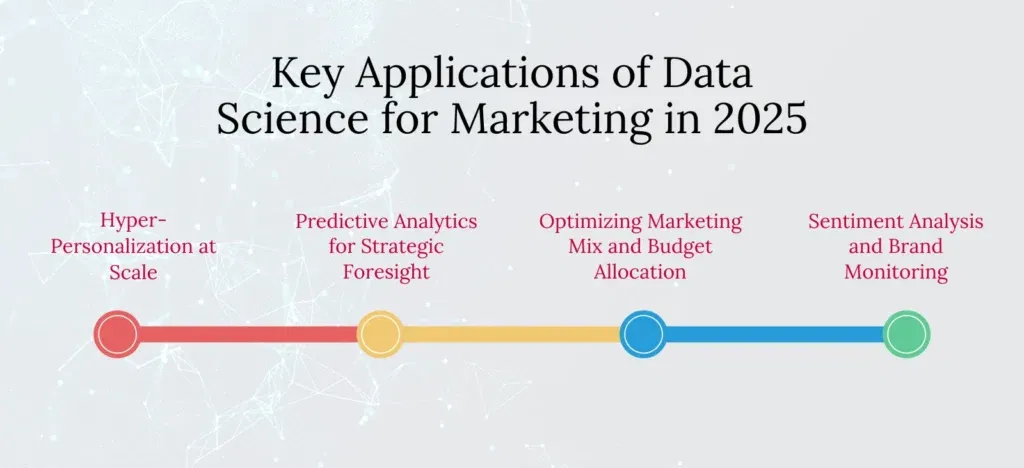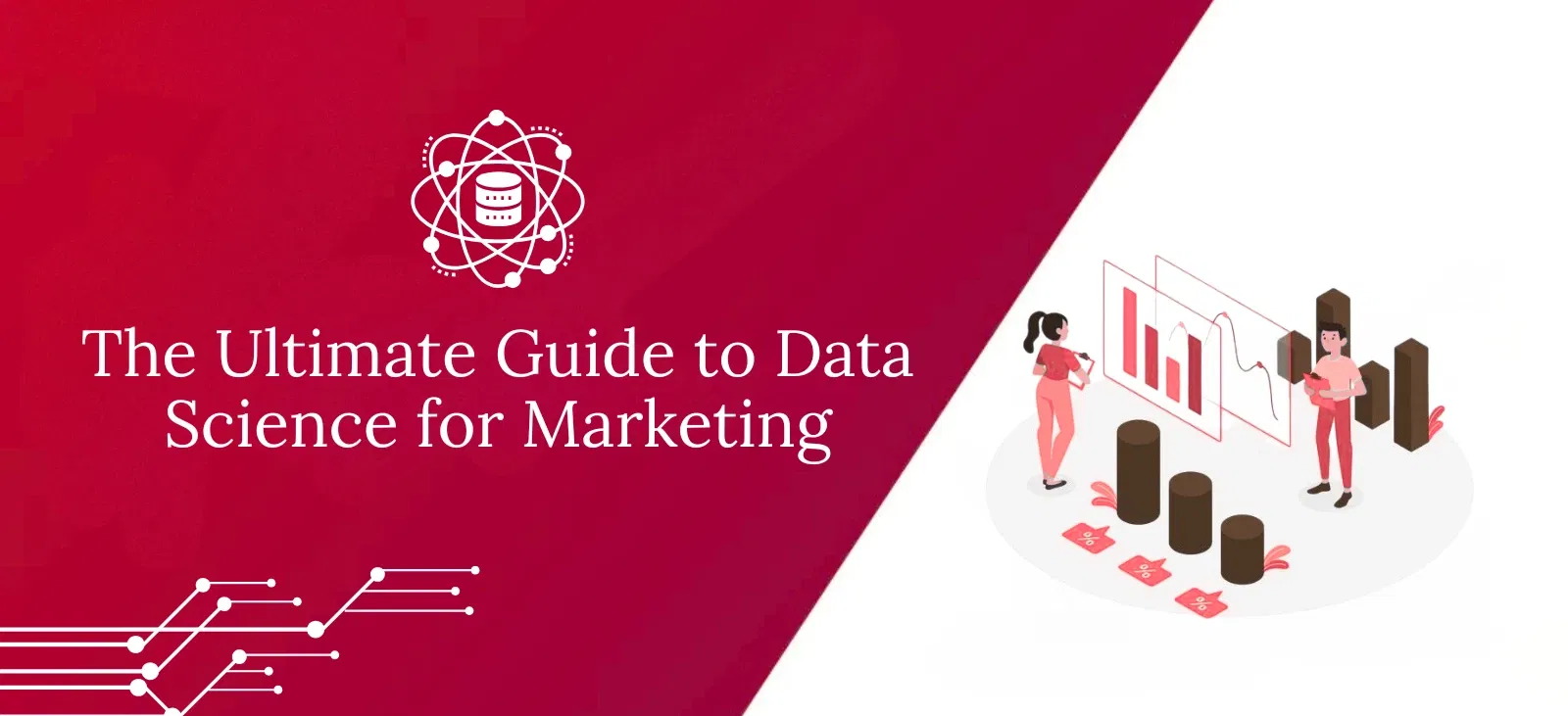Introduction
In a world where data is the new gold. Data science for marketing is not just an option but a need for companies looking to prosper.
In 2025, marketing data science and data-driven marketing strategies will complement each other. Traditional marketing philosophy is applied so completely to each marketing decision.
It will be purposeful; every marketing dollar will be optimised. Also, each interaction with a customer will be personalised.
The following article highlights how companies can harness data science. As a part of an intelligent and effective marketing strategy for the future.
The Evolution of Marketing: From Intuition to Insights
For decades, marketing was an art based on some trends and instincts and targeted to a broad demographic audience. The digital revolution allowed marketers access to more information on customer behaviour.
Of course, having an assortment of data is not enough. The difference between a valuable dataset and useless data. This lies in actionable insight. That insight is exactly what data analytics for marketing and data science can deliver.
By 2025, marketing will have embraced the use of technology and become a science. It allows marketers to advance beyond reporting. In the past of predictive modelling and hyper-personalization.
Key Applications of Data Science for Marketing in 2025

The enhancement brought about by the combination of data science with marketing. It can be illustrated in some of the key applications that are transforming marketing.
Companies are using data science for marketing in these various ways. It can achieve levels of precision. Also, effectiveness that has never before been realized.
1. Hyper-Personalization at Scale
Marketing of the past, where one-size-fits-all worked for a lot of marketing, is dying. By leveraging the power of data science for marketing. Marketers can move from larger segments to hyper-personalization.
With machine learning at their disposal, marketers can take billions of data points. Yet identify customer behavior. Also, buy history and browsing history to build experiences for customers.
Recommendation engines, like Netflix and Amazon. It suggests products (and content) the user is likely to engage with. Leveraging hyper-personalization is going to bring forth significant benefits. For better engagement, conversion rates, and customer loyalty for years to come.
2. Predictive Analytics for Strategic Foresight
Data science is one of the more powerful methods of forecasting and anticipating what will happen next. Predictive analytics in marketing can help predict. What a customer will do (if anything) before they even do it.
Example uses of predictive analytics in marketing include:
- Customer Churn Prediction:
By analysing customer behaviour. Many companies can identify those customers who may want to leave. Also, proactively engage them with retention offer campaigns.
- Customer Lifetime Value (CLV) Forecasting:
The ability to model likely revenue streams based on predicted revenue. A customer allows marketers to determine where to spend their efforts. As well as continually engage with high-value customers.
- Lead Scoring:
Machine learning models can be used to score and rank. The people who are most likely to convert into a sale. Marketing and sales teams could then spend their time. The resources on prospects who are likely to deliver for the business.
These analytical capabilities allow marketers to be more strategic. Through being proactive instead of reactive and doing “damage control” in last-minute campaigns.
3. Optimizing Marketing Mix and Budget Allocation
Must know which channels are driving the greatest achievements to optimise your marketing mix and budget. Marketing Mix Modelling (MMM) and advanced attribution models.
This uses the appropriate statistical methods to examine the contribution. From each channel to sales and key performance indicators (KPIs) in a quantitative way.
This is where data science comes into play. The role of data science is to understand the complicated journey of the customer. To give us a multi-dimensional view of multi-touch attribution.
Data science provides an optimal approach to allocating marketing budgets. Across all channels (i.e., social, email marketing, and traditional ads), with the greatest ROI.
4. Sentiment Analysis and Brand Monitoring
Today, with so much public discussion surrounding brands and their products. Yet, understanding public sentiment has never been more important.
Sentiment analysis applies Natural Language Processing (NLP) to sentiment in textual data. It is born from social media, customer reviews, and customer forums.
Sentiment analysis is a significant advantage. It provides real-time monitoring of whether public sentiment is viewed positively or negatively. Marketers can use sentiment analysis for several purposes:
- Detection of customer pain, and when dealt with quickly, reduces sentiment issues.
- Identification of brand crises where negative sentiment exists, through early warnings.
- Identifying opportunities in messaging that could help build deeper audiences.
The great part about applying sentiment analysis is that it provides a lot of feedback. Thus, we always know whether the brand’s message is resonating with customer perceptions.
Building a Data-Driven Marketing Strategy for 2025
To apply data science well, a clean and clear strategy is crucial. A good framework for achieving data science for marketing in 2025. It will often consist of some or all of the following steps:
1. Define Clear Goals and KPIs
Remember that clarity of what you wish to achieve with data science begins here. Set SMART (Specific, Measurable, Achievable, Relevant, Timely) goals.
Be it for sales, customer retention, or brand engagement. Your data science should align with whatever you wish to achieve.
2. Establish a Strong Data Infrastructure
A simple, good basis to work from. This means bringing together the many sources of data from all the tech stacks in an organisation.
Like CRM, marketing automation, web analytics, etc., together. Making sure that all the data is connected through a unified structure.
This will mean that every department and team that works together operates together. It will truly be leveraging the same sources of information to inform their activity.
3. Focus on First-Party Data
With third-party cookies phased out, first-party data has become vital. Organisations will ultimately need to invest. In their customers’ first-party data across web, apps, and loyalty programmes.
This primary data will be what organizations use with hyper-personalization. To provide the service that keeps their relationship. Also, commitment to their customers is sustainable and positive.
4. Embrace AI and Machine Learning
In 2025, data science tools will be powered by AI (artificial intelligence) and machine learning. AI and machine learning tools use algorithms to automate insights from data.
Solutions powered by AI can process immense volumes of data. Detect patterns that are impossible to achieve manually, and identify predictive models.
Commitment to digital transformation and to investing in AI tools. For necessity, if only for a competitive advantage.
5. Foster a Culture of Continuous Optimization
The modern marketing landscape is dynamic. At the time of this writing, the ideal ‘data-driven’ strategies will serve as a repeating loop.
Marketers will ‘dissect their campaign in progress’ and install changes. Also, maximize campaign effectiveness, and remove through testing cycles. Marketers must install a process for identifying. It’s making real-time improvements from their findings.
Upskill your marketing skills by taking a data science course with placement. This not only equips them with theoretical knowledge. But also provides practical, real-world experience. Ensuring they can effectively install and manage the data-driven initiatives outlined above.
Conclusion
The most effective marketing campaigns of 2025 will be those that use data and human creativity. In combining marketing with data science. We are a frontier away from advanced accuracy, personalization, and profitability.
Using data science for marketing, including predictive analytics and hyper-personalization. Also, with sentiment analysis, organizations will not only enable marketing success. But also build and nurture deeper and stronger bonds with customers.
The future of marketing is not about trusting our instincts and leaping but about how to leap based on data.

